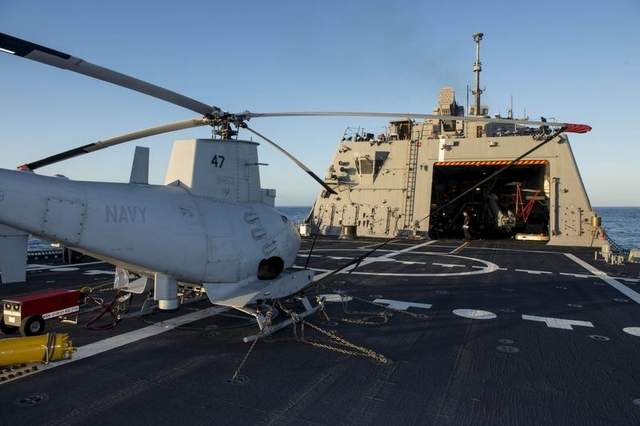An entirely new level of activity is taking place right now with the US Navy’s Fire Scout unmanned helicopter programme — for the first time, Fire Scout will be at sea on at least four ships at the same time — and they’ll be different kinds of ships, and both aircraft variants will be active.
It’s not unusual for the programme to announce one of its aircraft is at sea. A number of frigates have deployed with the system, and a littoral combat ship just deployed with one for the first time.
Two East Coast-based frigates are deployed with the helicopters, each carrying four MQ-8B variants. The Samuel B. Roberts is wrapping up a deployment around Africa, while the Simpson began a 6th Fleet cruise in mid-November.
Just days later, the LCS Forth Worth left San Diego for a planned 16-month Western Pacific deployment embarking a hybrid aviation detachment of one MQ-8B and one MH-60R Seahawk manned helicopter — the first time such a combination has gone operational.
On Dec. 2, the California-based Coast Guard cutter Bertholf got underway off Southern California carrying two Fire Scouts, the first time Coasties have operated the drone aboard a national security cutter.
The last MQ-8B was delivered this month, and on Dec. 3, Northrop Grumman delivered the first production version of the MQ-8C, a much larger version of Fire Scout with greater payload and range. Two Cs are being trucked across the country from California to Norfolk, Virginia, where they’ll be loaded onto the destroyer Jason Dunham — the first time a C model has gone to sea.
Altogether, it’s an unprecedented range of activity for the little helos.
“It’s a fantastic time, this month in particular,” said Capt. Jeff Dodge, program manager for PMA-366, the Multi-Mission Tactical Unmanned Aerial Systems office that oversees the program for Naval Air Systems Command, on Dec. 4.
Not all the embarks are aimed directly at operational needs. The Coast Guard concept demonstration, Dodge said, “will show what they can do with a large-sized aircraft.” Fire Scout, he said, “is probably on the large side of potential solutions for their cutters. I think they’re still trying to sort out what their need is.”
The Bertholf demonstration is using two 8Bs — one an instrumented test aircraft, the other fitted with a search radar, one of five Bravo models being upgraded with a small Telephonics ZPY-4 radar fitted in the nose.
A full Fire Scout operating system wasn’t installed on the Bertholf for the tests, scheduled to run about two weeks. “Instead of fully integrating the mission control station into the ship, we put it in a conex box,” Dodge said.
Similarly, the 8C flights from the Jason Dunham will “define the shipboard envelope for safe takeoffs and recoveries in terms of wind,” Dodge said. “We’ll make assessments at different pitch and roll attitudes, look how the aircraft behaves around the ship and understand the behavior.”
More operational tests with the 8Cs will be conducted next year, aimed at achieving an initial operating capability in the fall of 2016.
Once the last frigates are retired in the fall of 2015, only littoral combat ships will regularly operate Fire Scouts, Dodge said, but he added that Navy ships could be adapted to handle the unmanned system. “Either model can go on any air-capable ship,” he said. “It just requires the data link and landing system on board.”
There is a significant difference between the MQ-8B and MQ-8C models — the small B is based on the Schweizer 333 light helicopter, while the much larger C is developed from the Bell 407 helo. But the C shares most of its unmanned control systems with the earlier B version. The C is able to be armed and has significantly greater endurance, but the aircraft, Dodge said, “will do the same or similar mission sets.”
Procurement of the B model has ended, with a total of seven test and 23 operational aircraft delivered from Northrop Grumman. Seven of those aircraft have been lost in accidents or stricken, Dodge said. Two aircraft were damaged Oct. 28 at Wallops Island, Virginia, when their hangar was damaged in the explosion of an Antares rocket. One of those already has been repaired — it’s the radar-equipped unit operating from Bertholf — while the other is being repaired and will be returned to service, Dodge confirmed.
Plans call for the purchase of a total of 40 8C models, including two test models already in operation.
Photo: An MQ-8B Fire Scout is deployed aboard the littoral combat ship Fort Worth. – MC2 Antonio Turretto Ramos/ US Navy
Source: Defense News

